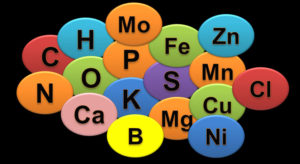Micronutrient management in plants is well known to the most experienced growers. Because although they are not needed in high doses, they help your plants achieve better performance. New growers, on the other hand, often overlook all the micronutrients their plants require to grow.
Plants need, in addition to NPK macronutrients (nitrogen, phosphorus and potassium), micronutrients in order to provide them with sufficient food. Finding the perfect balance between macronutrients and micronutrients in the soil will help you get healthier and more vigorous plants.
Nutrient categories
There are three different nutrient categories: primary nutrients, well-known macronutrients, or NPK (*did you know that water and air are also macronutrients?), secondary nutrients (those that plants need in smaller quantities) and micronutrients (those that are still needed in less than secondary ones). Among them they form the ideal diet of plants. And they are not even less important in the different phases.
If we think it and apply logic, it does not differ much from the ideal diet type for humans. Right?
*Water and air provide the necessary Carbon (C), Hydrogen (H) and Oxygen (O) throughout the plant cycle.
Secondary nutrients
Secondary plant nutrients are calcium (Ca), magnesium (Mg) and sulfur (S). These elements, although not needed in such high quantities, are necessary for good plant health. Sulfur helps develop vitamins, helps seed production and is an integral part of amino acid formation. Magnesium is a key component in the production of chlorophyll and helps plants use phosphorus and iron. However, in cannabis plants calcium plays an extremely important role.
Micronutrients reduction
Over the course of days and irrigation, it is normal for the arrangement of micronutrients in the soil to decrease, even following a specific fertilizer program. For example, in cases of high yield crops, where there is usually more time than normal in the growth and vegetation phases.
Another reason is that some fertilizers, such as NPK, contain lower or non-existent amounts of micronutrients as they focus on nitrogen, phosphorus and potassium macronutrients. Also, we can meet it in case of not arranging a fertile or quality soil.
Identification and functions
Each of the nutritional elements required for plants performs several functions. There are even some that help plants to properly absorb others of these elements. Since it is the case with hydrogen (H), which needs oxygen (O) from water and carbon (C) from the air to provide the basic components for plants to produce carbohydrates.
Iron
Iron (Fe) is an essential micronutrient for healthy plant growth. It is used by various enzymes and proteins during photosynthesis for the manufacture of chlorophyll. It helps with lignin formation, energy transfer and nitrogen reduction and fixation. It is responsible for the function, structure and maintenance of chloroplasts (components of plant cells and algae).
It also plays an important role in the breathing process, an essential function of life. Actively encouraging the production of chlorophyll and preventing leaf discoloration commonly found in dying leaves.
Boron
Boron (B) plays a very important role in bringing stability to plants. It helps cell membranes with their development, reinforcing their structure and is vital to regulate a plant’s metabolism. It is extremely important for plant growth, directly involved in germination, pollen formation and flower retention. Low boron plants can show hollow fruits and stems, as well as weak leaves.
Copper
Copper (Cu) activates some enzymes in plants involved in lignin synthesis and is essential in various enzyme systems. It is also required in the process of photosynthesis, is essential in the breathing of plants and helps the metabolism of carbohydrates and proteins in plants. In addition, it also serves to intensify the flavor and color in the vegetables and the color in the flowers.
 Zinc
Zinc
Zinc (Zn) mainly helps to produce chlorophyll. Without zinc, the growth of plants is atrophy and the leaves are discolored due to zinc deficiency. This discoloration is called chlorosis, which causes tissues between the veins to turn yellow while the veins remain green, which usually affects the bottom of the leaf near the stem.
Manganese
Manganese (Mn) is a metallic element and one of the 13 natural minerals in the soil. It is the backbone of the photosynthesis process and is the reason why the leaves have their green color. Chlorophyll cannot capture the energy of sunlight for manganese-free photosynthesis. Soils rich in organic matter are also richer in manganese, but manganese can leach from lighter soils such as sand. Soils rich in organic matter are also richer in manganese, but manganese can leach from lighter soils such as sand. For this reason, manganese deficiencies are often quite common in light soils or with limited organic matter.
Nickel
Nickel (Ni) helps the conversion of urea in plants, as it is a vital component of the enzyme urease. It is also believed to help with nitrogen fixation. To obtain a complete fertilizer for your plants, it may be helpful to choose one that includes nickel.
Chlorine
Chlorine (Cl) is a valuable plant micronutrient that helps with photosynthesis and the way plants use energy. More than chlorine, the plants that they use are chlorides that come from the chlorine that is present in the salt of the soil. Keep in mind that chlorine is very harmful to plants, so to be able to absorb it, they must be in a chloride compound.
And remember, to get the most out of your fertilizers (primary, secondary and micronutrients) in your crop, it is important to take into account the quality of the water. If we do not have a good quality inlet water, it is highly advisable (if not mandatory) to use a water treatment system. Available options are: Filtration Systems (REMOVE THE CHLORINE) or Reverse Osmosis Systems (LOWER THE EC).


